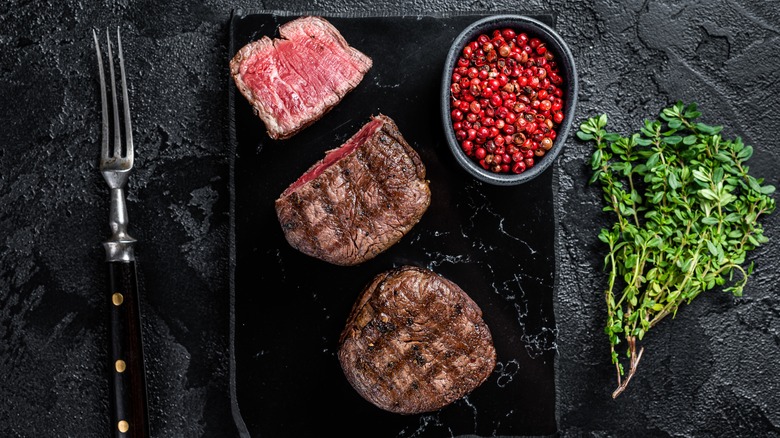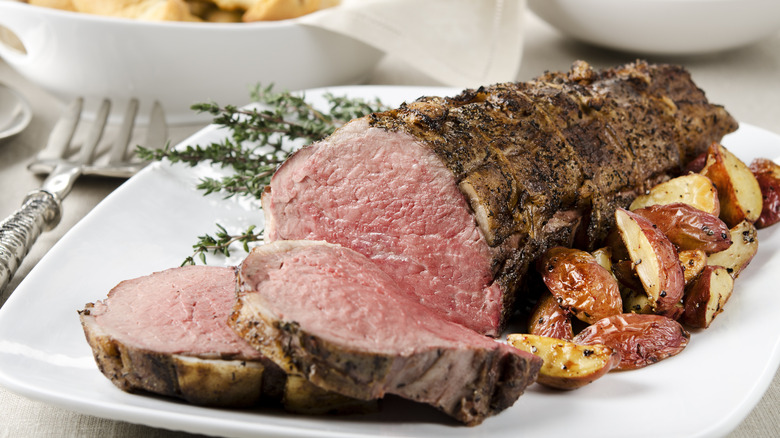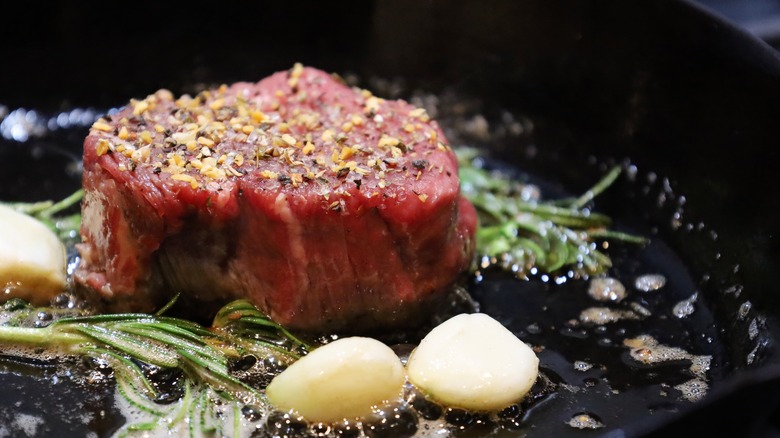Tenderloin Vs Filet Mignon: What Separates The Two Steaks?
Buttery soft and incredibly tender, nothing says "special occasion" like a tenderloin or filet mignon steak. Whether you're dining at a restaurant or trying to choose the perfect steak at the store, these are both expensive pieces of meat — but they're not the same cut, even though they do both come from the same part of the animal.
The term beef tenderloin refers to the entire tenderloin muscle, which can be up to 24 inches long and runs from the loin primal section to the sirloin primal of the cow. It can be used whole or in parts for roasting, or it can be cut into smaller steaks. (Fun fact: You get a portion of tenderloin on one side of T-bone or porterhouse steaks, with a strip steak on the other side of the bone.) And while the tenderloin is shaped rather like a dagger, narrower towards the front of the animal and getting wider towards the back, the narrower front end is actualy where filet mignon steaks are cut from.
Because of its position, the tenderloin muscle gets very little exercise, which makes both the tenderloin and filet mignon cuts exceptionally tender. They're less marbled than a New York strip or rib steaks (which were Anthony Bourdain's preferred cut of steak). The lack of fat means they may lack the robust beefy flavor of other cuts — but with careful cooking, the prized tenderloin cuts can offer a luxurious steak-eating experience.
More on beef tenderloin and how to cook it
The full tenderloin can weigh four or five pounds, and can feed eight to 12 people. There are only two tenderloins per cow, and after butchering, they yield less meat than some other cuts, which is one reason why tenderloins — and the filet mignons that come from them — are so pricey. However, the tenderloin certainly makes an impressive centerpiece.
If you're planning to cook a whole tenderloin, it's cheaper to buy it untrimmed and then trim and tie it yourself, but you can get your butcher to do it. Folding and tying the thin, pointy front end piece to the rest of the meat helps it cook more evenly, as it gives it a more uniform shape. Either roast the beef at a high heat, or at a lower temperature for longer before finishing it under the broiler or in a hot skillet to get a browned crust.
As well as the filet mignon from the front, the tenderloin also includes the cut called chateaubriand, which is cut from the center (so it's also known as the center-cut tenderloin). Because it's cut from the middle, it has a neater, more cylindrical shape, and is great for serving up to six people. It's the perfect cut if you want to make beef Wellington, since its shape means it cooks evenly and produces similar-sized portions when sliced. The rear, thicker part of the tenderloin is called the butt tender.
Filet mignon is a single steak and needs careful cooking
Since filet mignon steaks are only part of the tenderloin, you don't get many per cow — around 12 filet mignon steaks from one animal, compared to 16 strips and 20 ribeyes. Filet mignon steaks are also smaller than many cuts, and ideal for a single serving; they tend to measure between one-and-a-half and two-and-a-half inches in diameter, and weigh between four and eight ounces.
Its leanness makes the filet mignon the worst cut of steak for grilling, since it's easy to overcook. Rather than fierce heat, it suits a more careful approach in a skillet at a medium-hot temperature. Flip the steak frequently to get a good crust, and baste it in plenty of butter towards the end of the cooking time to add extra richness. It's a cut best served rare to medium-rare.
The reverse sear method also works well for filet mignon. Cook the steak low and slow in the oven, then when it's about 15 degrees shy of your desired temperature, finish it off in a hot skillet. This will ensure a nicely browned exterior, but a juicy, tender inside. Alternatively, if you prefer a chargrilled flavor, try switching to the petite tender cut — it's an affordable filet mignon alternative that is also lean and tender, but suits grilling better.



